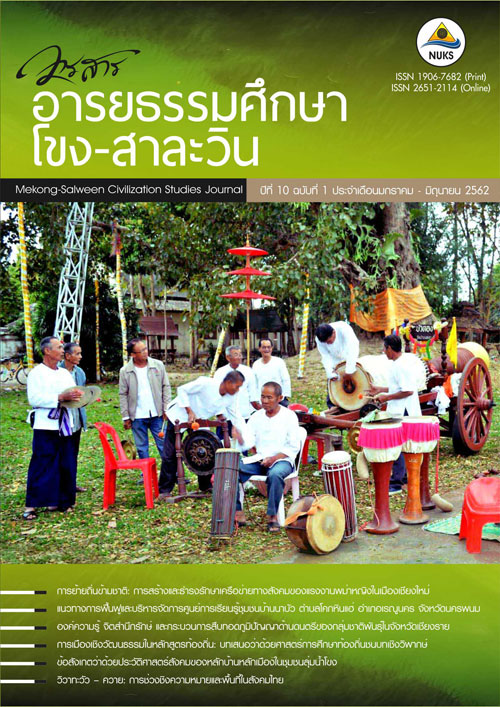ข้อตกลง
1. บทความทุกบทความจะได้รับการพิจารณาจากผู้ทรงคุณวุฒิ (Peer review) ที่ตรงตามสาขาวิชา โดยทุกบทความจะต้องผ่านการพิจารณาจากผู้ทรงคุณวุฒิ อย่างน้อยบทความละ 3 ท่าน
2. บทความ ข้อความ ภาพประกอบ และตารางใด ๆ ที่ตีพิมพ์ในวารสารอารยธรรมศึกษา โขง-สาละวิน เป็นความคิดเห็นส่วนตัวของผู้เขียน กองบรรณาธิการไม่จำเป็นต้องเห็นด้วยเสมอไป และไม่ใช่ความรับผิดชอบของ กองส่งเสริมศิลปวัฒนธรรม มหาวิทยาลัยนเรศวร ถือเป็นความรับผิดชอบของผู้เขียนแต่เพียงผู้เดียว
3. บทความจะต้องไม่เคยตีพิมพ์เผยแพร่ที่ใดมาก่อน และไม่อยู่ระหว่างการพิจารณาของวารสารฉบับอื่น หากตรวจสอบพบว่ามีการตีพิมพ์ซ้ำซ้อน ถือเป็นความรับผิดชอบของผู้เขียนแต่เพียงผู้เดียว
4. บทความที่ส่งถึงกองบรรณาธิการ ขอสงวนสิทธิ์จะไม่ส่งคืน
Migration: The Establishing and Maintaining of Social Networks of Women Burmese Migrant Workers in Chiang Mai City
การย้ายถิ่นข้ามชาติ: การสร้างและธำรงรักษาเครือข่ายทางสังคมของแรงงานหญิงพม่าในเมืองเชียงใหม่
Keywords:
migration, social networks, Burmese women workers, mirangrant workAbstract
This research focuses on migration, the establishing and maintaining of social networks of Burmese women migrant workers in Chiang Mai city. The aims are 1) to explain migration phenomena of Burmese woman migrant workers; 2) to analyze socio-economic motives of the woman migrant workers who migrate to the destination country; and 3) to study the establishing and maintaining of the woman migrant workers’ social networks in an area of the destination. Mixed method research, including qualitative and qualitative methods, is conducted. The study finds that the political instability situation raised from racial and cultural conflict in the Republic of the Union of Myanmar pushes the migrants to cross the border to Thailand. The economic hardship of the origin is another key factor that motivates the migrants to migrate to work in Chiang Mai city in Thailand. Considering the motives for migration, the result shows that social motive is lower than economic. While overall level of social motivation is 2.87 on average, economic motivation is 3.724 on average.Generally, before migrating, the migrants have some weak social networks in the destination. However, after migrating, they must establish strong social networks among the transnational migrants to accommodate their needs and adaptation in the unfamiliar situations in the destination. The social networks and social relationships, such as friends and acquaintances, are usually established in a work place, construction site, church, or temple. This study finds ways to strengthen and maintain the social network of Burmese migrant woman workers: 1) the development of environments or situations that stimulate the social networks, social activities, and network managements; 2) the development of network organization and 3) persuade the migrant workers to participate and join as a member in order to help or support their social and economic problems.
References
Agranoff, R. (2003). Leveraging Networks: A Guide for Public Managers Working across Organizations. School of Public and Environmental Affairs. USA: Indiana University–Bloomington.
Archavanitkul, K. and Vajanasara, K. (2009). Employment of Migrant Workers under the Working of Aliens Act 2008 and the List of Occupations Allowed to Foreigners. Research Report. Bangkok: International Organization for Migration (IOM).
Astone, N. M., Nathanson, C. A., Schoen, R. and Kim, Y. J. (1999, March). Family Demography, Social Theory, and Investment in Social
Capital.Population and Development Review. 25(1):1-31.
Bourdieu, P. (1986). The Forms of Capital. In Handbook of Theory and Research for the Sociology of Education. Richardson, J. Pp. 241–58. Westport. CT: Greenwood.
Chareonwongsak, K. (2000). Network Management: Important Strategies to the Success of Education Reform. Bangkok: Success Media Co., Ltd.
Chiangmai Immigration Bureau. (2017). Area of Responsibility. Retrieved September 12, 2017. from https://www.chiangmaiimm.com/ th-th/2016-06-05-02-24-27.html
Chiangmai Provincial Labor Office. (2016). Labor Situation in Chiangmai. 1st Quarter, January - March 2016. Publication. Chiang Mai: Office of Labor.
Coleman, J. (1988). Social Capital in the Creation of Human Capital. The American Journal of Sociology. January 94: 95-120.
Dunlop, N. (2011). Invisible People Stories of Migrant Labourers in Thailand. Bangkok: Raks Thai Foundation.
Ek-Iem, B. (2003). Social Capital: Definitions and Theoretical Perspectives of Social Network and Community Development. Journal of Extension and Development. Chiang Mai: Maejo University.
Human Rights and Development Foundation. Officer. (2016, May 1). Interview.
_____________. (2016, August 17). Discussion Group.
Kanjanadith, B. (2006). The Way of Life of Migrant Workers from Myanmar in the Bangkok Area: A Case Study of Migrant Workers in the Thai-English Language Program of the Democratic Campaign Committee in Myanmar. Bangkok: Office of the National Culture Commission. Ministry of Culture.
Keaw. Woman Burmese Migrant Worker. (2016, August 30). Discussion Group.
Labour Market Research Division. (2011). Northern Labour Market Situation. Publication. Bangkok: Department of Employment. Ministry of Labour.
Lee, E. S. (1966). A Theory of Migration. Demography. April (3) 1:47-57.
Ministry of Social Development and Human Security (2016). Migrant Workers Statistics. Social Statistics Processing Document. September 2016. Bangkok: Ministry of Social Development and Human Security.
Nam. Woman Burmese Migrant Worker. (2016, August 30). Discussion Group.
Ngen. Woman Burmese Migrant Worker. (2016, April 4). Interview.
_____________. (2016, August 17). Discussion Group.
_____________. (2016, August 30). Discussion Group.
Office of the Permanent Secretary, Ministry of Labor. (2008). Labor Situation in the Third Quarter of 2008. Bangkok: Ministry of Labor.
Office of Work Permit. (2018). Statistics of Foreign Workers Permitted to Work Remaining throughout the Kingdom. March 2018 issue. Bangkok: Department of Employment, Ministry of Labor.
Panthaloet, W. (2012). Lao Women Working in Karaoke Bars in Thailand: Migration and Living Across Borders. 1 st Conference on Graduate Student Network of Thailand. (18 December 2012). Bangkok: Thammasat University.
Pearson, E. (2006).The Mekong Challenge Underpaid, Overworked and Overlooked: The Realities of Young Migrant Workers in Thailand, Volume 1. Institute for Population and Social Research. Mekong Sub-regional Project to Combat Trafficking in Children and Women. Bangkok: Mahidol University.
Purisinsith, V. et al. (2000). Basic Concepts of Social and Cultural. Department of Sociology and Anthropology. Chiang Mai: Chiang Mai University.
Ratnatilaka, Na Phuket, P. (2009). Organization and Management. Nonthaburi: Think Beyond Books.
Ravenstein, E. G. (1885, June). The Laws of Migration. Journal of the Royal Statistical Society of London. 48(2): 167-235.
Sai. Woman Burmese Migrant Worker. (2016, August 30). Discussion Group.
Soi. Woman Burmese Migrant Worker. (2016, May 1). Interview.
_____________. (2016, August 17). Discussion Group.
Stoloff, J. A., J. L. Glanville, E. J. Bienenstock. (1999, January). Women’s Participation in the Labor Force: The Role of Social Networks. Social Networks. 21(1): 91–108.
Wan. Woman Burmese Migrant Worker. (2016, April 20). Interview.
_____________. (2016, August 30). Discussion Group.
Wayne, W. (1997). Psychology: Themes and Variations Engage Learning. USA: Washington.








